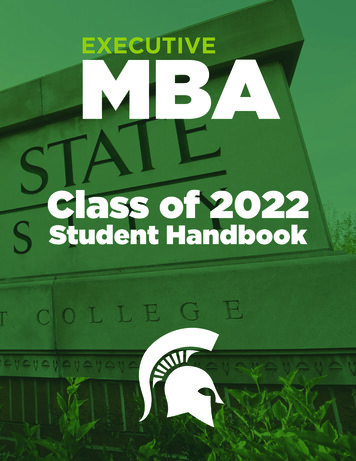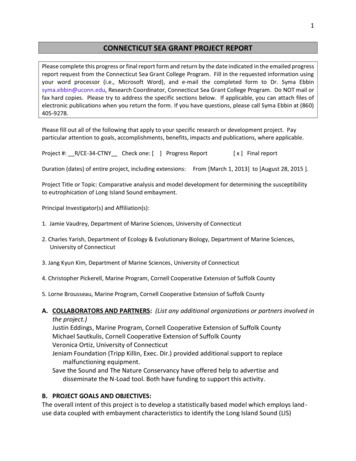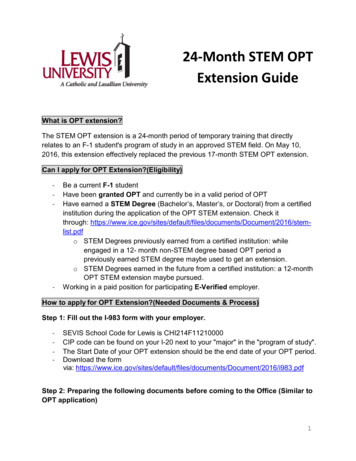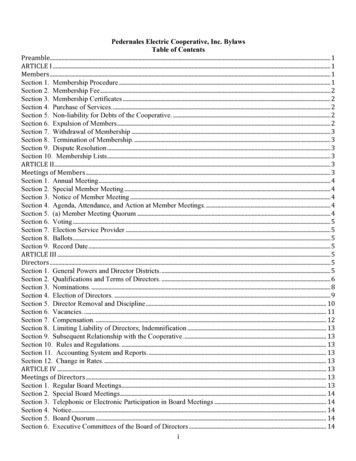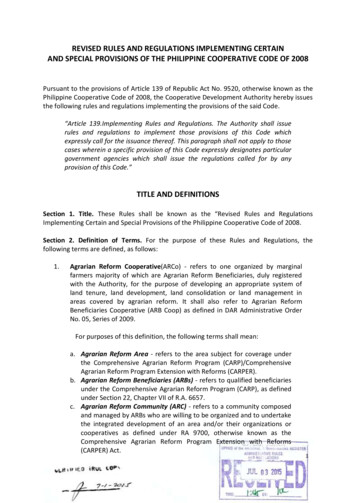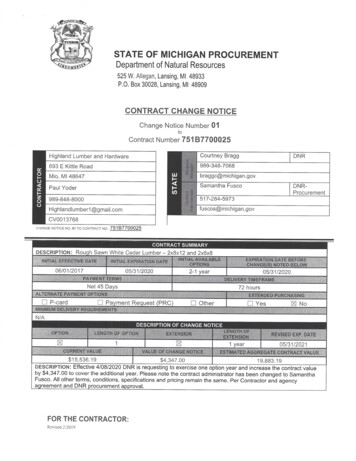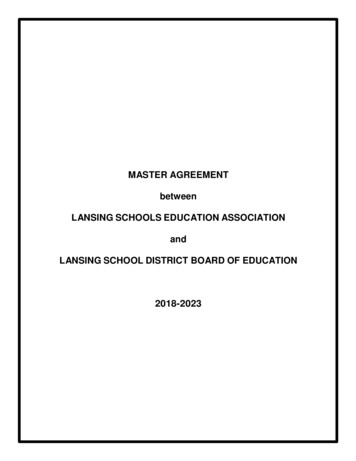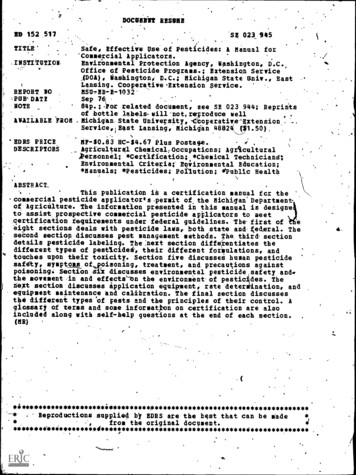
Transcription
DOCONEIT RESUMEED 152 517'sg 023, 945.TITLEINSTITOTIONREPORT 10Safe, Effective Use' of Pesticides: A Manual for'Commercial Applicators.Envifonmental Protection Agency, Washington, D.C.Office of Pesticide Programs.; Extension Service,(DOA), Washington: D.C.; Michigan State Univ., EastLansing. Cooperative. Extension Service.MSUT-EB-E-1032'PUB' DATESep 761MOTE84p.;-Por related document, see SE 023 944; ReprintsAVAILABLE FROMof bottle labels- will 'not, reproduce wellMichigan. State University, ltboperative xtensionService, East Lansing, Michigan 48824: 41.50),'EDRS PRICE.DESCRIPTORS4!.-4MF-10.83 HC-14.67 Plus Postage.Agricultural Chemical:Occupations; Agricultural.0ersonnel; *Certification.; *Chemical Techniciand:Environmental Criteria; Estiironmental Education;*Manuals; *Pesticides; Pollution; *Public Health,e.rABSTRACT,This publication is a certification manual f cr the-cosmercial pesticide applicator's .permit of the Michion'Departmentof kgricilture. The information presented in this manual is designeto assist prospective commercial pesticide applicators to meetcertification requirements under federal guidelines. The-first ofeight sections deals with pesticide lags, both state and, 4ederal. Thesecond section discusses pest management methods. The third sectiondetails pesticide labeling. The:next section diffientiates thedifferent types of pesticides', their different for ulations, andtouches upon their toxicity. Section five discusses human pesticidesafdty, sysptossof,Joisoning, treatment, and precautions againstpoisoningi Section six discusses environmental pesticide safety and.the movement ,in and effectelon the environment-of pesticides. Thetext section discusses application equipment, rate deter nation, andequipment maintenance and calibration. The final section discussesthe different types sof pests and the principles of their control. Aglossary of terns and some information on certification are alsoincluded along with self-help questions at the end of each **********************************Reproductions supplied by EDRS are the best that can be made4from the original ******************************
; 1.50.c.E THISPERMISIO%%.EEBerNn.ard LukcotiTi) THE EDu ATIONAL RESOIJRcESINFORMATION CENTER IEFIIC1 'ANDUSERS OF THE ERIC SYSTEM*U STDEPARTMENT OF NEACT'NEDUCATION 1WELFARENATIONAt INSTITUTE OFEDUCATi6N,BEEN 4PPOrS DOCUMENTE %AC r,r A s FELL .E ;ROMHE PERSON OR 04,ANIZA,ON WL,NOPINIONS.TINE IT POINT., Or,TATEO 00 NOT- NE'tESSAR.e.Y RfERRE4ENTOf PICAL NATIONAL 1NST TL/TE OFEOUCAT ON POSITION OR POLICYATExtension Bullet's( E-1032, Sept. 1976COOPERATIVE EXTENSION SERVICEMICHIGAN STATE UNIVERSITYSAFEf EFFECTIVE USE OF PESTICIDESA MANUAL FOR COMMERCIALPLA1.-5-o-nLs.,"TORS
rPY'ocedure. s for Certification of Commercial ApplicatOi.sA person desiring .to become certified as acommercial applicator in the State of Miqhi-be self-teaching and contains a studywith self-help questions at the end ofofeaChsection.Tliis manual addresses only the gen-gan is required -to successfully complete aminimum of two written examinations, oneaddressing the general standards set forth ineral standards required of all commercialapplicators. The specific standards ,requiredthe federal regulations (40 CFR 171.4(b) and for the category or subcategory, and the171.6), and the other(s), the specific require- additiaal requirements for aerial applicationments of the category or subcategory (40 CFR or space fumigation, are contained in separate171.4(c) and Regulation 636-Rule 4). A person' ;unit manuals. Check the unit manu4s 'reapplies.pesticideseby aircraft or. by space ceived to assure that you have the rkcessaryfonrigation is required to susfully com- study materials for eabh category or subcateplete an eiariiination foj e method of appli- gory in which y toidesire to-become certified.cation entployedgulation 636 Rule 4(b)).).Examinations will be givenbyby appointmenetj,Examination questions will be based onStudy materials contained in, the training-*manuals t4t have been developed by theMicniganate University Cooperative Ex-at any of the exam nation sits listed on th.fee receipthas been returned to you.Bring the fee receipt card with you to the ex-amination site and -present it to the lamina-lion monitor(foltension Service.- Each Manual is.designed to4ittarree.').91/ISOME SUGGESTIONS FORS,TUDYING THIS MAN ALThe information presented in this manual is designed to assist prospective commercial applicatorsThen study one section of the ma ual at 'a time.You may want to underline igloo ant points in,the manual or take wlitten nbtes as you studythe section.4. Answer, in writing, the ses if -help questiopi atthe 4nd of each section. Instructions on how touse the'self-help questions in yoUr studrare ineluded with the questions. These questions areintended to aid you in your study.,and to helpyou evaluate your knowledge of the subject. Assuch, they are an important part of your study.5. Reread the entire manual once again when youhave fi A shed studying .all fits sections. Revt-ew with care any sections that you feel you donbt fully understand.3.to meet the certification requirements under theffederal guidelines. You may already know some ofit from your experience with pesticides. The manual has eight sections. A list of self-help questionsand instructions for completing the questionsare contained at the end of each section. Thesequestions are to 'assist you in.your studies and arenot necessarily the qtiestions on the certificationexamination. If you encounter difficulties in usingthe manual, please consult your county extensionagricultural agent or4epresentative of the' Michigan Department of Agriculture for assistance.Some suggestions for striding the manual are:1. 'Find a place and time for study where you will 'not be disturbed.2. Jd the entire manual thiough once to un-.1,This Manual is intended to help you use pes-ticides effectively and safely when they are'rstand the scope arid form of presentation ofe material.'Aft0,needed. We hope that you will review it occasionally to keel the material fresh in your mind.USE PESTICIDES SAFELY AND EFFECTIVELY3
,SECTION IrPesticide 'aiesPublic Law 92-51692nd Zongress, H. R. 1;4729tOCtober 21, 1912,,.21n 2lct86 STAT.C, amend the Federal Insecticide. Fungicide, and Rodenticide Act, find folother purposes.ArBe it enacted by the Senate and House of Representatives" of the Federal, United States of America in Congress assembled, That this Acrmay Envi ronn.Pestioldbe cited as the "Federal Environmental Pesticide Control Act Of 1972".Contro2AMENDMENTSTO FEDERAL INSECTICIDE, FUNOICIDE,,AND RODENTICIDE ACT.,SEC. 2. The Federal Insecticide, Fungicide, and Rodenticide Act('61 gta(7 U.S.C. 135 et seq.) is amended to read, as follows :78 Ste"SECTION L.SHORT TITLE AND TABLE OF CONTENTS."(a) SHORT TITLE. .This Act may be cited as the' -ederaI:Ide, Fungicide,and Rodenticide Ace.7,secti-a RLE OF CONTENTS.rFEDERAL LAWS. AND REGULATION5.Federal Environmental PesticideConirol ActThActThere are several unlawful acts defined in theamendments which affect both pesticide producer pFederal Environmental Pesticide/cOntrand th; ultiniate users. The unlawful acts whichEPCA) of 1972 substantially a ends' eare important to you are listed below:Detach, altef, or destroy any part of a label.Refuse to keep records, refuse to permit inspection, or refuse to permit sampling.,Nfike a restricted use pesticide available to anyone not certified.Fede al Insecticide, Fungicide, and Rodent 'c}deAct ( IFRA) of 1947. FIFRit, was a mist ed bythepartrnent of Agriculture unt auth . 'ty wastrans erred to the Environme tal P otectionAgencY in 1970.Use a restricted use pesticide unless theHere, are some of the major rovis ns providedby the 1972 amendments wh' 'h are ost important'.,applicator is certified, or the application is.rnadeby a competent person under the direction orsupervision of a certified applicator.''Use any registered pesticide in a manner incon-to you:pe1.esticidesticide buses mu'general .otsrestricted.be c ssified as either'sistent with its labeling.2. Pesticide applicator must ecome. certified ifthey wish to use re tricte pesticides.3. The 1972 law ext &to estates the authorityto certify applicdt rs, re ster pesticides, and initiate programs/ desi ed to meet their loCaIneeds.-4. EPA and the tates ill engage in a cooperativeprogram in force ent of the law and trainingneeds.e act provides 'civil penalties and criminalpenalties far individuals who violate provisionsof the actCivil PerialtieSo,1 A private applicator "who violates the Act afterwritten warning, or after a citation for a,priorviolation, may be.assessed a fine bf not rnore than 1,000 foi each offense.Any comniercial applicator who violates the actmay lie assessed a fine of not more than 5,000 for,each offense.110
Criminal Penalties/.Aerial application: Application of pesticidesfrom airplanes is regulated by the Federal AviationAdniinistration (FAA). Under FAA regulations it isA private applicator who knowinglY violates theact is guilty of a misdemeanor and upon conviction, kay be fined not more than 1,000 or impra-illegal for an aerial applicator to apply any pesticide except according to federally registered use.FAA determines the flying ability of.agricultural.pilots-and the afety of their aircraft. .oned for not more than 30 days, or both.IIA commercial pplicator who knowingly violatesthe act is guilty of a misdemeanor, and upon conviction, may be fined not more than 25,000' or imY prisoned for not more than one year, or both,Residues: Another law regulates he amount of apesticide that may remain on raw agricproductsthe residue. These amounts (cal ed tolerances) are set by EPA when the pesticid use is'registered. ToleranoeA are expressed in ter ofrt by weight of the pesticide for each 1 mi ionpartsparts by weight of the agricultural 'product. hesame pesticide may have a different tolerance ondifferent products'. For example, it might ,have atolerance of 50 parts per million (PPM) on grapesand 25 PPM on apples.i1'RegulationsTransportation: Shipment of pesticides andother dangerous substances across state lines is.regulated by the Federal' Department of Transpor-tation (DOT). The -DOT's Hazardous MaterialsRegulations Board issues the regulations for pre paring these materials for transportation. Theboard has grouped the materials into three classes;with separate standards for each class'.Most pestickles are 'in the middle category"Class B'phisons." This means that they are somewhatdangerous., poisons which are toxic tg,man andwhich create a llealth hazard during traiisportaty.4If too much residue is' found on a product beingshipped front; one state to anothei, the shipmentmay be seized and destroyed.Instructions on all Pes-ticide labels take thesetolerances and residues into account. They will tellyou how many days before harvest the pesticidemay be applied., By folleWing the directionsexactly, you can be sere that you are not violatingthe la*.2.5
Occupational Safety Ad Healthing vehicles of transport, where pesticide or de-vices are being used or held for distribution orsale, for the purpose of inspecting and obtainingsamples lof Ay pesticides or devices or inspectAct of .1970The Purpose of Congress in passing this law wasto assure safe and healthful .working conditions forevery. working man and woman in the nation, andto preserve our human resources.The OSHA requires -anyone with eight or moreequipment or methods of application.most applicable to the certification of pe/s4cideapplicators is prdvided below to aid you inemployes to kee'p certain records aid makeA(A stimmar-y of ,he provisions of the ac't whi5:h arefamiliarizing yourself with "Actperiodic 'reports. Most imporfantly, he must keepgood records of 'all wort-related deaths, injuriesand illnesses. Minor injuries needing only first aidtreatment need not betrecorded. But a record mustbe made if the injury involves:medical treatment,Pesticide ApplicatorsAny' person who uses orrestricted use pesticidetified.supervil the use of arequire4'to he cer-Any person who shall adrrtise in any form orwho holds himself out to the public as being inloess of consciousness,restriction of workor motion, ortransfer to another job.the business of applying pesticides shall obtain alicense prior to eugagin in such business. .A licensed applicator shall comply with the cer-MICHIGAN PESTICIDECONTROL ACTtification requirements whether he uses a restricted use pesticide or not.Certification re.quirements are prescribed inl'he Michigan Pesticide Contro Act was enactedto conform with -the requiremen OF the FPCA.The act gives authority to the director of theregulations promulgated by the director.A certification fee of 10 must accompany theapplication for a certificatpesticides sold within the state and to register pes-Certification is .viifid until revoked or for, aMichigan Department of Agriculture to registerperiOd of three years.A license fee of S20 must accompany the -application for a license or renewal. The license shallexpire December 31 annually.ticides for special local needs. Authority is alsogranted for the director to certify applicators whouse restricted .use pesticides, license pesticideapplicators engaged in the business of applyingpesticides, and license dealers who sell restrictedLicensed applicators must prckide proof of fianancial responsibilityi.usxestiaides.e act/gives the director authority to promul-,gate regulations for carrying out the provisions ofthe 'act, including' but not limited to gulationsproviding for:.1. The collection; examination, and reporting theresults of examination of samples of pesticidesor devices.2'. The safe handling, transportation, storage, display, distribution,-and dispiisTil pesticides andtheir containers.3. The designation of use Pesticides for the stateOr for specified areas within the state. The Director may include in the regulation the timeand conditions of sale, distributioj and use ofsuch restricted use pesticides.4.,,The certification and licensing of applicators,and the licensing of restricted use pes idedealers.Restrictions;" Denial of Certificateor Licens'etto accomplish proper application of the pesticides to he lised.3. If the director does not qualify the Applicantunder this section; he shall inform the applicantin-writing of the reasons therefore.5. Retiring certified com mercialiipplicatorsto.t.Exemptionsfrom Act.maintain records with respect to a pplications ofrestricted use pesticides and maa such reportsas the director shall require by regulation.6. Good practice.in the use of pesticides.7. Certified applicators to use a pesticide in1. The certificate or license may restrict the applicant to use a certain type of equipment or pesticide if the director finds that the applicant isqualified to use only such type.2. Tel g director may refuse to issue a certificate oricense or renewal thereof if the applicant demonstrates a insufficient knowledge of any itemcalled- for n the application, has unsatisfiedjudgments against him, or if* the equipment tobe used'by theopplicant is unsA or inadequate1. Employees of a certifipd private applicatoracting under th/e supervision of suchapplicator.a2. ,Commercial applicators applying general use'manner consistent with sits labeling includingadequate supervision of noncertiffed applicators'where appropriate.pesticides indoors .other than insecticides,roclenticides, avicides and molluscicides.3. Persons applying general use pesticides on'The director is, authorized to enter upon anytheir own Premises, or employees of such per-,.;sons on such premises.public or Okivate preniises or other place, includ7639s
4- 4. Doctors of medicine and doctors of veterinarymedicine applying pesticides during the courseof their' normal practice.5. Personvonducting lahoiatory type research "involving restricted use pesticides-.adequate manner, or in a-manner inconsistent withits labeling, the director 'shall order the app)icatorto cease the use of or refraitifrom the intended useof such pesticide, mixtures, equipment or methods.The order may be,either oral or written, and mustinform the applicator of the reason therefore.Upon receipt of the order, the applicator shall-Reciprocity,Th,e Director 4nay enter into feciproc'alagreements with other,state or federal agencies forthe purpose of accepting certification required for'Pesticide applicattirs, provided that such states orfederal agencies have an apprOved program to certif)., applicators, and provided further that the re.quirements.for certification by such states or fed:.eral agencies equal or exceed the certification requireivents of this state., immediately comply there with. Failure to complyLiability .A certificate or license issued by the directoring order of the director may be oral and Theapplicator may rely thereon. However, an oralshall not exonerate the holder from responsibilityfor damage resulting frorn misuse of p ,sticidessuch as, but not limited to, overdosing,drifting, or.der.Revocation, ,suspension of certificate or license:.constitutes cause for revocation of the -license orcertification and subjects the applicator to thepenalty Imposedundeii section 16 of theMlichiganPesticide Control Act. .The director of agriculture shall rescind theorder immediately upon being satisfied after inspection that tht reason therefore does not or nolongeeexists. The inspection shall be conducted assoon as possible at the request of the applicator,which may be either oral or written. The rescind-order shall be followed by a written rescinding or:The director may at any time revoke; or suspend acertificate or license for a violation of t is act orregulations, or.any, order isSued hereunde or uponRestricted Use Pesticides.conviction undersectio 14 of the FIFRA, or uponSales, or distribution 4-restricted use pestii4gTh conviction of any stag pesticide law of ar y recipshall be limited to licensed restricted use pesticide rocating state.deaers for resale or distribution to applicators certified under this att.'PenaltymisapplicatiOn.,Any person who shall violate 4ny of t pro Enforcementof the Michigan Pesticide Control Act orStop use order Whenever the director shall have 'regulations promulgated thereunder is guil of areason to believe that an applicator is using or in-. misdemeanor. Fines are levied at the discre ion oftending to use a pesticide in an unsafe or 4n-the court.Self -Ijelp Questions on Section1Pesticide LawsWow that you have studied eetion 1, answer the following questions. Write the answers with pe pil,without refer.rin& back to the text.When you are satisfied, With you written answers, see if they are correv by checking them with the text.* Erase your answer and write inthe correct answer if ybur first answer is wrong: Note that' these ques:Hats are not necessarily those t at are used in the .Certification examination.1. What agency administrates the federal pticide laws?tar,2. What are some unlawful acts defined in heffileral.law?A1.;3. Can violators of the pesticidq laws be impr'onedtThe qtkstions Are arranged in the order that they Appear in the text7S-
4. What agetcy regulates the shipment of pesticides aclioss state lines?t9. Who needs to be certified for pesticide application under the Michigan law?.5. Is it legal for an aerial applicator to apply a10. Does .a licenc.9(1 applicator also require certifi-cation if he does not use restricted use peg--pesticide thae)s.at registered?.ticides?6. What is meant by a pesticide residue?.11. 9oes'a person working under the supervisionof a certified applicator .also need to be certified?iv.7. Are you required to keep health and ,,safetyrecords under the Occupational Safety andHealth Act if you emplob five people?12. Do dealers settling restricted use pesticidesneed to be licensed?8. Who administra/t s the Michigan Pesticide.AControl Act?13. What does a stop use order 'mean?.I 4185
p.SECTION 2: Pest ManagementWe often talk about the "war" against insects, ordiseases, or weeds, or rats. In a war between countries, would a general use only the army against histion as often as needed? Alte,rriatives are to treatblockade, the air fgrce to, destroy sources of muni-.house. This is an obvious example of sound pestenemy? Would he not also think about'navy totion, propaganda to reduce the enemy's will tofight, etc? If he would consider nuclear weapons,only the house foundation are ?A; keep wood out ofcontact with the grobrid; and use barriers to keeptermites from. getting into wooden members of themanagement.he would also consider the consequences OfClub Root of Cabbagedangerous fallout.Yet, In our "war" againstkpests, how often do weCabbage and other, cole crops have been grownfor sevetal years on a faim. The club root diseaseorg4nism is so plentiful that cabbage production isno longer profitable. tine solution would be to killthe 'pathogen with a sutable soil pesticide and repeat as often as requir d. Good pest management,use the handiest or cheapest pAticide withoutthinking of a better combination of methods or qf.consequencips to file environment? Possibly, itistoo often,management, or integrated pest managemanage- , on the other hand, w uld have prernte8 thement,ment, is a modern philosophy of pest c1ntrol that buildupof the diseaseusing disease-free trans- N.says we should employ all useful tactics to keepplants and rotating the c op.1pests below econo ally harmful levels with aThesearesimpleandlitherobviousexamplesofminimum harmful patt to the environment. Letpestmanagement.Othercouldbecitedonmanyus look at some amples.different crops, including cotton, soybeans, citrusand apples. Some:Of these are complex, involvingEXAMPLES OF INTEGRATEDseveral control strategies.'PEST 4ANAGEMENTMany of the tactics and iminciples of pest managementagementhave been kno n and used for manyPreventing Termites in a Npw Howseyears. But the concept as ch, the toms, and someSuppose a neW house is to be built on a lot of the methods are relative y new.wheie termites are plentiful and potentially deOur environment includes many kinds of plantsstructive. Do we treat the entire property with an and animals, These interact with one anotits ndinsecticide to kill all termites'and repeat the opera- with the physical world Cf soil, water and air. 111.61
undisturbed ,"nature" there is a balance and considerable stability but this situation does not provide usadequate food and fiber. To providethese, we have cut dur forests, plowed our prairies,and planted crops. In so doing, we have favored.contr.ol or help'to reduce such pests. Biologicalcontrol is most common for insects, wites and someweeds.Cultural Controlcertain plants and, animals. But in so doing wePlanting, growing, harvesting and tillage prachave also provided abundAit food and shelter fortices may be 'favorable or unfavorable to pests.other plants and animals that are harmful to orrr' Plowing and cultivating, for example, are harmfulcrops and animals. These other plants and animalstc weeds and to some insects and diseases. Butweeds, disease qrganisms, insects, rodents,.and -they may. help to spread disease organisms andbirds we call pests.nematodes. Other cultural practices such as cropThus we see that when we change our environ- rotalgn, time of planting and fertilization all influment, we change the interactions among plants andence pests. Using cultural practices that reduceanimasometimes in our favor land sometimestest numbers and avoiding those that favor pestsnot. 0 problem, then, is to makeenvironwill help protect crops. On some crops, 'this may be.ment ess favorable for pests but still favorable forour crops. How can we do.this?The methods we use to redu'ce pest numbers wecan call "tactics." Some of these follow.the only control you needySOME TACTICS OF PESTMANAGEMENT.Resistant VarietiesCrops and animals vary widely in their resistance to pests. By using resistant types, we makethe environmentless favorable for pests arrd easierfor us to keep them below harmful levels.PesticidesPesticides must be used in many situationswhere other tactics cannot prevAt tharmful pestlevels. Proper ,useisadequately describedelsewhere in this manual. The pest manageinentconcept includes the .use of pesticides where theyare needed and can be used safely. But theyshould be selected and used in a manner harmoniou with other tactics and not harmful to the environment. Using pesticides along with biological,cultural or other methods often works better thanusing any, one of these methods.by itself.Biological Control'.*Many of our pests are introdtIced from othercountries. Finding nd introducing their naturalparasites, predators; and disease organisms often.:-i
Other Tacticsdestroying cotton stubble in, the fall soon afterharvest to reduce the weevil food supply,killing weevils before they hibernate by apply-. Other tactics tinchide attractants for monitoring(or in sorhe instances control); hormones for control of weeds and insects, sterile male release, asing insecticides in the late -summer and. fall.for the screw worm; quarantine to prevent pestwhen they do not interfere with biological control of other pests, andspreadi.to new areas; and. eradication to eliminatepests completely.'planting trap crops in the spting and treatingthem with insecticides.This integrated system operated along with careful monitoring for outbreaks of pests provides satisfactory pest control with a miniriaminfa pesticides.The way these tattles are used together inteis the strategy in pest management. Anexample will help tb show this. The cotton boll' weevil is so serious that it must be controlled bypr.sticides to produce a profitable crop. But insecticides applied during the regular season also killgratedA new way to predict., if and when pests willreach economically damaging levels (economicthiesholds) is being developed, It uses monitoring,sampling and computet analysis.You should know about pest management pro-parasites and predators that normally control cottonboll worm, white flies, and other potential pests.The integrated pest management system for cottonhelps avoid this problenVIt involves:grins in progress in your area so you can workwith them-to provide the best possible pest protection.cm,0.11,4.04111t00o,7"Ci:?not Oe C."),r711t\ESIINGFLEDIfa NOE:ANIS:stFt%ACID1Ws f %5PE510fPOSAIAit.ICliAADENAcAlcCr%00-0A cAEWslEftED001 OftEEPGALLO%COIAPOIAAIIONOf vESIOffOf AA3 OSCANS AIMSPIAO,"7 cire08028REP,CH110%SO". CINIOCAAzMFG BYtaltosti04012ALS0047 sIA'tc.1.1ta El1.14Pm0.81351.4244
.(Self-Help Questions on Section 2Pest Management.Now that yOu have studied Section 2, answer the following cities:tions. Write the answers with Pencil without.referring back to the text.When you are satisfied with your written answerssee if they are cor-.rect by checking them With, the text*,Erase your answer an4 write inthe'correct answer if your first answer is Wrong. Note,that these clues. dons are n.ct necessarily those that are used in the certification examination.1. What is meant by "pest management"?*4. Could time -of planting ba pest?culturaViTontrolfor.2. What is a "resistant variety "?.5. When should pesticides. be used undemanagement concept?4;!.he pest3. Biological conttbl is most commonly usedagainst what types ofpets?\%k6. What .affect do pe;ticidesweettl control have on the parasites and prtdators of the weevil and other insects?'The queshons are arranged in the order that they appear in the text9,
.6kSECTION 3: Labels and Labeling.,What is a label? What is labeliAg? They are simi-lar words, but they do not mean exactly the samething. First let's discuss the label. You know that itis the information printed on the can, box or bag ofpestiTosell."This label serves many purposes':manufacturer, the label is a license toTo the state or federal regulatory agency, thelabel is a way to control the production, distribution, storage, sale, use and disposal of the products.PARTS OF, THE LABEL0Brand NameFEvery product has.its own brand 'name.sThis tellsyou what company the product came from.The brand,name is featured prominently on thefront panel, and is the most advertised and identifiablemame for the product. .RESTRICTED USE PESTICIDEThelabel is also .the best way for regulatoryAll NIA. IMO ID am1NCI0.0.1.1111.611SONI. 06111111110agencies to tell users about necessary safety andenvironmental precautions.To the buyer or applicator, the label is the best source of infoimation needed to use the. productsafely.MINCYANI1Men. PMRESTRICTED USEPEST!:Z. .rttr rtPM MT. 10. 10 fl YR.SI 4: ;GM. &MUM,. 011/1.41.6IMINT4 ANNIr".7 r "Efo DEPEFAI11111,10.MT.1rt wry. Neff onennallgaZmw.7,I.IL/IMO ON. atm* 000Newtwr0810.KW OUT OfILACII Of MORINDANGER .-- POISON -41 11f,,,z.WYNN,AM.,*1111/ NM./Maga XC.7.:7; ;r {2(I. 11,VO0OW I. Nanft 11,14,110Sle ilunanmednerrioionsW MOSTRTKOOP,*M.: Mfg24-5-a 1- :ffilty exonl On OWNCommon NameThe common name for' a ch ical is a nameagreed upon to identify an active gredient in aproduct. A chemical inanufactuy more thanone company may be sold unde several brandnames, but you may find the sarn common nameon all of them.Labels on containers are like people; some areorderly and fairly easy to understand, while othersWs. Or.togigure them out But all labels will live theatm Pisto basic information you need, because this s required by laW. This section will explain all thei tems that must be :on 'Idabel. You should beabout the product. Labeling includes such thingsas brochures, flye)Thiss and information handed out atmaterial must not differ in ethe point of salemeaning from t e information the manufacturerkairA tcrEPA when the product was registered foruse.PEXTOFFwortSalOUR1.11.ma Amway1!IMMO@P.M.4.0IMP OW Of MCA Of 0111.DIDIPOISONDANGERIIW011710toPMlPooh ma poorer.I. 14roeto amranoown.00 um
of kgricilture. The information presented in this manual is designe to assist prospective commercial pesticide applicators. to meet. certification requirements under federal guidelines. The-first of. eight sections deals with pesticide lags, both state and, 4ederal. The. second section discusses pest management methods. The third section


